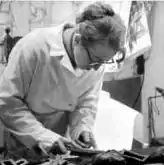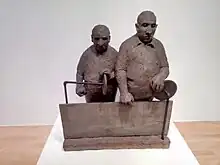Ghisha Koenig | |
|---|---|
 | |
| Born | 8 December 1921 London, England |
| Died | 15 October 1993 (aged 71) |
| Education | |
| Known for | Sculpture |
| Notable work | The Machine Minders |
| Spouse | Emanuel "Manny" Tuckman |
| Children | 1 |
Ghisha Koenig (8 December 1921 - 15 October 1993) was a British sculptor whose work focused on the work place, especially factories as a hub of human activity.[1]
Life
Ghisha Koenig was born in London on 8 December 1921, the daughter of Leo Koenig (1898-1970), art critic and writer, and his wife, Fanny Hildebrand (fl. 1900-1940), formerly a Yiddish actress.[2] In 1950, she married Dr. Emanuel (Manny) Tuckman, and they had one daughter, Sarah.[3] She died on 15 October 1993.[3]
Work
Koenig studied at the Hornsey School of Art, the Chelsea School of Art with Henry Moore, and the Slade School of Art.[4] During World War II she was a member of the Auxiliary Territorial Service.[5]

Between 1955 and 1956 she spent time observing and sketching people at work at an ink factory in Kent. The resulting sculpture was created in clay and made in cast concrete. It was called "The Machine Minders" and is at Tate Liverpool.[6]
Her first solo exhibition was at the Grosvenor Gallery in London in 1966. She also had a solo exhibition at the Serpentine Gallery in London in 1986. This exhibition included works created from 1968 to 1986 from three series, The Glassworks, The Tentmakers and The Plate and Coil Shop.[1] Factories she visited or worked at included J & E Hall, Dartford (APV Products Ltd) which made escalators and salination systems, the Plate and Coil Shop, and the Fettling Shop.[7] Many of her sculptures are done in bronze or terracotta bas-reliefs.[8]
Her work is in the permanent collection of the Tate Gallery,[4] the Museum of Labour History in Manchester, Middleheim Museum in Belgium, the Graves Art Gallery in Sheffield, the City Art Gallery in Stoke-on Trent, Homerton College in Cambridge, and the City Art Gallery in Manchester.[9] Public commissions include the Ministry of Work, 1950; Festival of Britain, 1951; St. John the Divine, 1961; Dalton House School, Sevenoaks, Kent 1986.[9]
Exhibitions
- 1953, 1958, 1960, 1963 The Royal Academy
- 1958-61 Society of Portrait Sculptors
- 1959 Smithsonian Institution, Washington
- 1963, 1964, 1966, 1968, Grosvenor Gallery, London
- 1974 Ghisha Koenig Sculpture 1968-74, Bedford House Gallery, London[10]
- 1978 Wins Arts Council Award solo show at Galerie Husstege, Holland
- 1986, retrospective solo exhibition at the Serpentine Gallery[11]
- 1986, 1994, 2005, 2010 Boundary Gallery, London;
- 1993 Tate Gallery, London
- 2017 Ghisha Koenig: Machines Restrict Their Movement, Henry Moore Institute, Leeds
References
- 1 2 "Ghisha Koenig: Sculpture 1968-1986". Serpentine Galleries. Retrieved 5 March 2016.
- ↑ "Ghisha Koenig". Oxford Dictionary of National Biography (online ed.). Oxford University Press. 2004. doi:10.1093/ref:odnb/52209. Retrieved 5 March 2016. (Subscription or UK public library membership required.)
- 1 2 The Independent: Obituary: Ghisha Koenig - People - News - The Independent, accessdate: 28/08/2014
- 1 2 Foster, Alicia (2004). Tate women artists. London: Tate. p. 130. ISBN 9781854373113.
- ↑ Collins, Judith; Lindner, Elsbeth; Tate Gallery (1 January 1993). Writing on the wall: women writers on women artists. London: Weidenfeld & Nicolson. ISBN 0297813692.
- ↑ Label on the Machine Minders in the Tate in Liverpool read in 2019
- ↑ Steyn, Juliet (1994). "Juliet Steyn remembers Ghisha Koenig". Women's Art Magazine.
- ↑ American-Israeli Cooperative Enterprise (2013). "KOENIG, GHISHA". Jewish Virtual Library. Retrieved 5 March 2015.
- 1 2 "Untitled Document". www.boundarygallery.com. Archived from the original on 1 June 2012. Retrieved 5 March 2016.
- ↑ "Ghisa Koenig - Artists - Art Fortune". www.artfortune.com. Retrieved 5 March 2016.
- ↑ Judith Collins & Elsbeth Lindner, ed. (1993). Writing on the Wall, Women Writers on Women Artists. Weidenfeld & Nicolson. ISBN 0-297-81369-2.
External links
- 10 artworks by or after Ghisha Koenig at the Art UK site